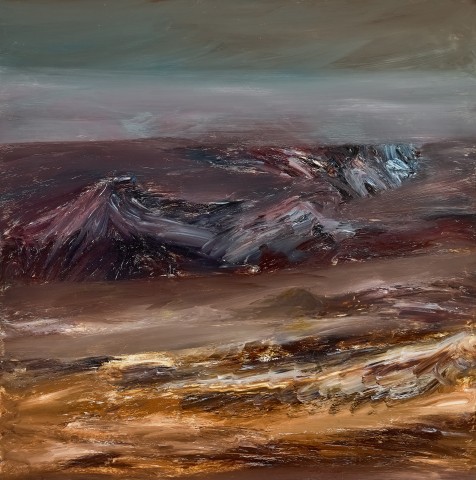LANDSCAPE, 1966
SIDNEY NOLAN
oil on composition board
122.5 x 122.5 cm
signed and dated lower right: nolan 1966
signed, dated and inscribed with title verso: 28 sept / 1966 / Nolan / Landscape
Lord McAlpine of West Green, United Kingdom
Private collection, London
Gould Galleries, Melbourne
Private collection, Queensland, acquired from the above in 2001
Sidney Nolan: Paintings, Peter Wenning Gallery, Johannesberg, April 1976, cat. 5 (illus. in exhibition catalogue)
Sidney Nolan: Landscapes and Legends, Gould Galleries, Melbourne, 7 March - 15 April 2001; Sydney, 2 May - 3 June 2001, cat. 35 (illus. in exhibition catalogue)
Upon moving permanently to Europe in 1953 with London as his base, Nolan’s poetic vision widened and flourished steadily as his career and travels increased exponentially. In particular, the mid-1960s was a period of grand ambition and personal transition for the artist, as attested by a partial overview of his travel itinerary: Antarctica, Australia, England in 1964; Australia (again), New Guinea, Indonesia, Nepal, Pakistan, Afghanistan, China and New York in 1965.1 It was a whirlwind life, punctuated by periods of intense studio activity where Nolan created serial imagery based on sketches, photographs and his own fulsome imagination. His painting techniques also varied, from squeegee marks applied to pigment mixed with alkyd resins; oil paint loaded with juicy, thick medium; or washed backgrounds of thin colour rubbed into the board with rags, then scraped back with his fingers. The masterworks from these years are many, and include the multipanelled epics Riverbend I, 1964 – 65 (Australian National University, Canberra); Riverbend II, 1965 – 66 (News Limited, New York); and Glenrowan, 1966 (Carnegie Museum of Art, Pittsburgh). Whilst all were based on specific locales, such as Victoria’s Goulburn River for the Riverbend paintings, each was also sufficiently removed from reality to create a singular illusory landscape suited to the particular mood of the story Nolan wished to convey.
As Bryan Robertson elucidates, increasingly Nolan’s art of this period revealed ‘the habit of imagination’ – a generalised imagery in which legend, history and reality are inextricably yet pointedly fused together.2 Accordingly, the present work, painted in London in September 1966, does not describe a specific locale but more likely features a composite landscape, betraying stylistic affinities with a myriad of locations and themes which Nolan was revisiting during these months, including the blacksoil plains of the remote Wimmera district where he was stationed during the Second World War; the mysterious, shadowed world of Antarctica with its icy mountain peaks looming menacingly against a dark sky; and the rich, red desert expanse of fiery heat, intense light and infinite space that so typifies his iterations of the Burke and Wills and Ned Kelly motifs. With its rich painterly technique creating textural scumbles here that echo the undulating terrain, Nolan’s portrayal through such figurative and expressive means moreover provided stark conceptual and aesthetic contrast to the prevailing hard-edge abstraction that dominated the period. As Elwyn Lynn elaborated in 1965, ‘contemporary painting was in the midst of a wave of abstraction of simple structures, uniform colour and Pop and Op art that relied upon commercial art’s meticulous means…’3 and similarly, upon the unveiling of Nolan’s celebrated polyptych Riverbend I at his Australian retrospective in 1967, John Henshaw suggested that the ‘lush romanticism’ of Nolan’s art offered viewers much-needed refuge from ‘the boredom of hard edge.’4
Layering fear and awe, fact and myth in a manner reminiscent of the great Romantic painters of the nineteenth century such as J.M.W Turner, Constable and Casper David Friedrich, thus Landscape presents Nolan’s reverence for the wild Australian outback in all its immense beauty and terror. Notwithstanding its production abroad, indeed the painting still bears a strong sense of the artist being present and observing with unflinching gaze the power and scale of nature; as Henshaw continues, ‘Allusion, suggestion and ever-present fantasy conjured up long after the visual experience has passed, in no way affect Nolan’s astonishing ability to convince the spectator that what he paints is real.’5
1. See Clarke, J., Sidney Nolan: Landscapes and Legends, exhibition catalogue, National Gallery of Victoria, Melbourne, 1987, p. 23
2. Robertson, B., ‘Biography, and Chronology of the Pictures’, in Clark, K. et al., Sidney Nolan, Thames and Hudson, London, 1961, p. 49
3. Lynn, E., Sidney Nolan – Australia, Bay Books, Sydney, 1979, p. 46
4. The Australian, 16 September 1967
5. Ibid.
VERONICA ANGELATOS
